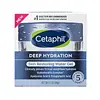What's inside
What's inside
 Key Ingredients
Key Ingredients

 Benefits
Benefits

 Concerns
Concerns

 Ingredients Side-by-side
Ingredients Side-by-side

Water
Skin ConditioningCaprylic/Capric Triglyceride
MaskingAmmonium Acryloyldimethyltaurate/Vp Copolymer
Phenoxyethanol
PreservativeGlycerin
HumectantBenzyl Alcohol
PerfumingSodium Hydroxide
BufferingTocopheryl Acetate
AntioxidantCucumis Sativus Fruit Extract
EmollientEthylhexylglycerin
Skin ConditioningSodium PCA
HumectantUrea
BufferingDehydroacetic Acid
PreservativeSodium Hyaluronate
HumectantTrehalose
HumectantLeuconostoc/Radish Root Ferment Filtrate
AntimicrobialPotassium Sorbate
PreservativeSodium Benzoate
MaskingPolyquaternium-51
Skin ConditioningWater, Caprylic/Capric Triglyceride, Ammonium Acryloyldimethyltaurate/Vp Copolymer, Phenoxyethanol, Glycerin, Benzyl Alcohol, Sodium Hydroxide, Tocopheryl Acetate, Cucumis Sativus Fruit Extract, Ethylhexylglycerin, Sodium PCA, Urea, Dehydroacetic Acid, Sodium Hyaluronate, Trehalose, Leuconostoc/Radish Root Ferment Filtrate, Potassium Sorbate, Sodium Benzoate, Polyquaternium-51
Water
Skin ConditioningGlycerin
HumectantDimethicone
EmollientPropanediol
SolventPanthenol
Skin ConditioningNiacinamide
SmoothingOctyldodecanol
EmollientSodium Polyacryloyldimethyl Taurate
Emulsion StabilisingXylitylglucoside
HumectantAnhydroxylitol
HumectantAllantoin
Skin ConditioningDistarch Phosphate
AbsorbentHydroxyacetophenone
AntioxidantXanthan Gum
EmulsifyingAcrylates/C10-30 Alkyl Acrylate Crosspolymer
Emulsion StabilisingCaprylyl Glycol
Emollient1,2-Hexanediol
Skin ConditioningTrehalose
HumectantUrea
BufferingXylitol
HumectantHydrolyzed Hyaluronic Acid
HumectantPolyglutamic Acid
Skin ConditioningPentylene Glycol
Skin ConditioningSerine
MaskingSodium Hydroxide
BufferingPantolactone
HumectantAlgin
MaskingDisodium Phosphate
BufferingGlyceryl Polyacrylate
Pullulan
Sodium Hyaluronate
HumectantGlobularia Alypum Leaf Extract
Skin ConditioningCitric Acid
BufferingPotassium Phosphate
BufferingWater, Glycerin, Dimethicone, Propanediol, Panthenol, Niacinamide, Octyldodecanol, Sodium Polyacryloyldimethyl Taurate, Xylitylglucoside, Anhydroxylitol, Allantoin, Distarch Phosphate, Hydroxyacetophenone, Xanthan Gum, Acrylates/C10-30 Alkyl Acrylate Crosspolymer, Caprylyl Glycol, 1,2-Hexanediol, Trehalose, Urea, Xylitol, Hydrolyzed Hyaluronic Acid, Polyglutamic Acid, Pentylene Glycol, Serine, Sodium Hydroxide, Pantolactone, Algin, Disodium Phosphate, Glyceryl Polyacrylate, Pullulan, Sodium Hyaluronate, Globularia Alypum Leaf Extract, Citric Acid, Potassium Phosphate
 Reviews
Reviews

Ingredients Explained
These ingredients are found in both products.
Ingredients higher up in an ingredient list are typically present in a larger amount.
Glycerin is already naturally found in your skin. It helps moisturize and protect your skin.
A study from 2016 found glycerin to be more effective as a humectant than AHAs and hyaluronic acid.
As a humectant, it helps the skin stay hydrated by pulling moisture to your skin. The low molecular weight of glycerin allows it to pull moisture into the deeper layers of your skin.
Hydrated skin improves your skin barrier; Your skin barrier helps protect against irritants and bacteria.
Glycerin has also been found to have antimicrobial and antiviral properties. Due to these properties, glycerin is often used in wound and burn treatments.
In cosmetics, glycerin is usually derived from plants such as soybean or palm. However, it can also be sourced from animals, such as tallow or animal fat.
This ingredient is organic, colorless, odorless, and non-toxic.
Glycerin is the name for this ingredient in American English. British English uses Glycerol/Glycerine.
Learn more about GlycerinSodium Hyaluronate is hyaluronic acid's salt form. It is commonly derived from the sodium salt of hyaluronic acid.
Like hyaluronic acid, it is great at holding water and acts as a humectant. This makes it a great skin hydrating ingredient.
Sodium Hyaluronate is naturally occurring in our bodies and is mostly found in eye fluid and joints.
These are some other common types of Hyaluronic Acid:
Learn more about Sodium HyaluronateSodium Hydroxide is also known as lye or caustic soda. It is used to adjust the pH of products; many ingredients require a specific pH to be effective.
In small amounts, sodium hydroxide is considered safe to use. However, large amounts may cause chemical burns due to its high alkaline.
Your skin has a natural pH and acid mantle. This acid mantle helps prevent harmful bacteria from breaking through. The acid mantle also helps keep your skin hydrated.
"Alkaline" refers to a high pH level. A low pH level would be considered acidic.
Learn more about Sodium HydroxideTrehalose is a disaccharide made of two glucose molecules (glucose is sugar!). Trehalose is used to help moisturize skin. It also has antioxidant properties.
As a humectant, trehalose helps draw moisture from the air to your skin. This helps keep your skin hydrated.
Due to its antioxidant properties, trehalose may help with signs of aging. Antioxidants help fight free-radical molecules, unstable molecules that may damage your skin.
In medicine, trehalose and hyaluronic acid are used to help treat dry eyes.
Some animals, plants, and bacteria create trehalose as a source of energy to survive freeze or lack of water.
Learn more about TrehaloseUrea is also called carbamide and is the diamide of carbonic acid. In cosmetics, urea is used to hydrate the skin. It also provides exfoliation in higher concentrations.
As a humectant, urea helps draw moisture from the air and from deep within the skin. This helps hydrate your skin. Studies show urea is an effective moisturizer for dry skin conditions. 40% urea is typical in medications for treating eczema and other skin conditions.
Urea has the strongest exfoliation effect in concentrations higher than 10%. It is a keratolytic agent, meaning it breaks down the keratin protein in the top layer of skin. This helps remove dead skin cells and flaking skin.
In medicine, urea has been shown to help increase the potency of other ingredients, such as fungal treatments.
Humans and animals use urea to metabolize nitrogen-containing compounds. Urea is highly soluble in water. Once dissolved, it is neither acidic nor alkaline.
Learn more about UreaWater. It's the most common cosmetic ingredient of all. You'll usually see it at the top of ingredient lists, meaning that it makes up the largest part of the product.
So why is it so popular? Water most often acts as a solvent - this means that it helps dissolve other ingredients into the formulation.
You'll also recognize water as that liquid we all need to stay alive. If you see this, drink a glass of water. Stay hydrated!
Learn more about Water